Fix connected to WiFi but no Internet access error in Windows
If you see the scary Windows 10 or Windows 11 Internet connection icon informing you that you don't have Internet access, the following article will show you what to do when you don't have Internet access even though you're still connected to Wi-Fi. -Fi in Windows.
What does Wi-Fi connection without Internet access mean?
Before continuing, it's worth explaining what's happening on the network when you're connected to Wi-Fi but don't have Internet. This requires knowledge of some basics with home networks.
Wireless devices, such as laptops, connect to the router. A router is a device that manages network connections for devices in the home. The router plugs into a modem, a device that connects traffic on the home network to the wider Internet.
When you see an error message like Connected, no Internet access or Connected but no Internet on your computer, it means that the computer is correctly connected to the router but cannot access the Internet. On the contrary, if you see the message Not connected, no Internet or No Internet connection , it means that the computer is not connected to the router at all.
This provides some clues that lead to the remedies below.
Fix connected to WiFi but no Internet access error in Windows
1. Confirm other devices also cannot connect
Before troubleshooting any problems, it's important to determine if the PC is the only device without an Internet connection. Take your phone (or other device connected to the WiFi network) and see if it's online - try streaming a YouTube video to test.
On some Android versions, this problem is indicated by an X over the Wi-Fi icon in the status bar. iPhone and iPad users can go to Settings > Wi-Fi and check if the No Internet Connection message appears under the network name.
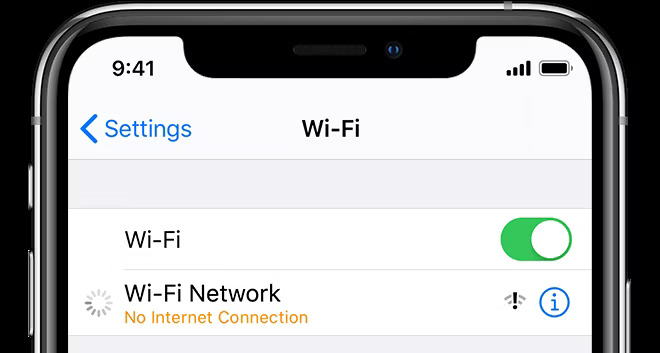
If your Windows computer doesn't connect but other devices do, this may be due to misconfigured settings on the PC. But if there's no Internet on every device, the problem lies with the network device and so some of the PC-only steps below can be skipped.
Before continuing, if the problem affects all devices, a quick check should be performed. Disconnect the Ethernet cable connecting the modem to the router and instead use this cable to connect the PC directly to the modem.
If you can get online using this setup, the problem is with the router. Therefore, if the following troubleshooting is performed and there is no result, the router may be defective.
2. Restart your PC
This step is not necessary if the connection problem affects multiple devices.
As with many problems, restarting your computer is the first troubleshooting step to try. If you're lucky, any temporary errors can be fixed by restarting, which should fix your PC's network connection problems.
Most advice assumes you're using a Wi-Fi connection as they tend to have more problems. However, if you connect your computer to the router using an Ethernet cable, you should try another cable to confirm that the cable is not defective.
3. Restart the modem and router

Since most network problems are related to modems and routers, restarting them is a wise first step. Although some routers provide the option to reboot through a web interface, there is no need to do this. Unplug the power plug from both devices for a few minutes or use the physical power button if available.
First power back on the modem, let it boot up completely before plugging the router back in. Wait a few minutes to make sure both are running. While doing this, confirm that the router and modem are working properly. If any lights are not visible on one of the devices, or the lights appear red or blink irregularly, the network hardware may be faulty.
If your computer says "No Internet" later, continue with the next troubleshooting method.
Note that you are just rebooting, not resetting the device. Reset means returning the device to its factory default settings; You don't have to do that yet!
4. Disable all VPN connections

Using a VPN has many benefits, but it also adds an extra layer to the process of establishing an Internet connection. Therefore, what you think is a problem with your home network connection may be a problem with the VPN. Sometimes a VPN will time out if the connection takes too long while the PC is idle or uses an overloaded server that can't handle the connection.
If you're running a VPN, whether through an app, a manual connection in Windows, or on your router, turn off the VPN and try to get online again. If that doesn't fix it, turn off the VPN for the remaining troubleshooting time to reduce the number of variables.
5. Run Windows Network Troubleshooter
This step is not necessary if the connection problem affects multiple devices.
If you're only having problems with your Windows PC, there may be a problem with your computer's network settings. Although Windows' built-in troubleshooter often fails to resolve the problem, it's still worth a try before moving on to more advanced steps.
To access the network troubleshooter on Windows 10, go to Settings > Network & Internet > Status . Select Network troubleshooter and follow the steps to see if Windows can fix the problem.
On Windows 11, you will find this tool at Settings > System > Troubleshoot > Other troubleshooters > Network and Internet .
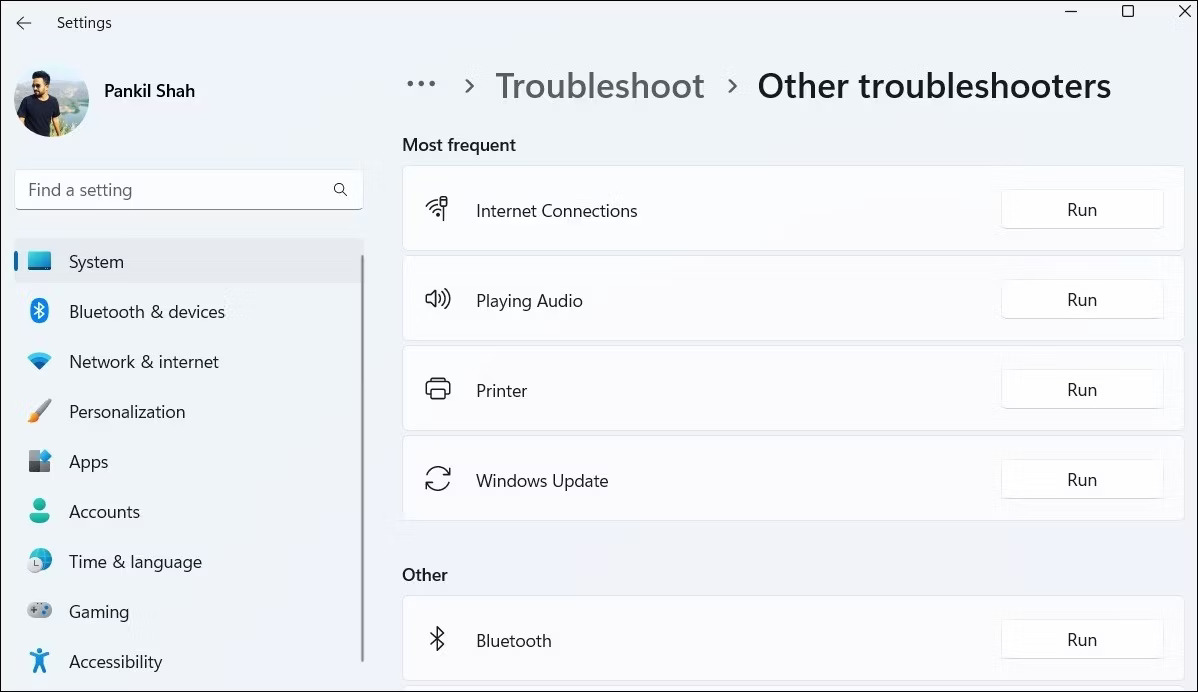
6. Check IP address settings
This step is not necessary if the connection problem affects multiple devices.
Next, one of the key steps to diagnose network problems should be performed: Confirm that the computer has a valid IP address. In most home networks, under normal circumstances, the router will provide addresses to devices when they connect. If your computer's IP settings are incorrect, it may cause "cannot access the Internet" issue or IP conflict.
Review IP settings on Windows 10
When using Windows 10, go back to Settings > Network & Internet > Status . Click Change adapter options and then double-click the connection in use.
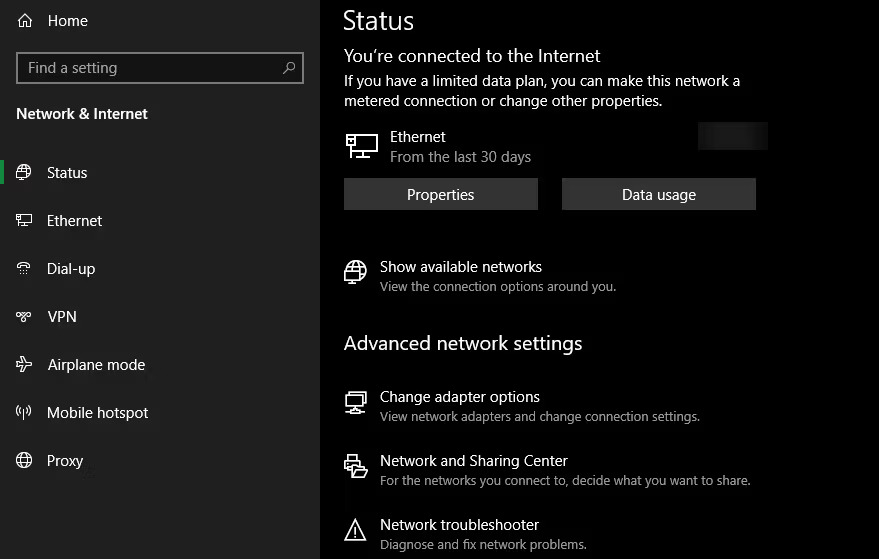
When you open a window with information about your connection, click the Properties button . Find Internet Protocol Version 4 in the list and double-click it.
There, make sure Obtain an IP address automatically and Obtain DNS server address automatically are selected . Manually setting an IP address is for advanced use; Chances are if you enter something here it's invalid.
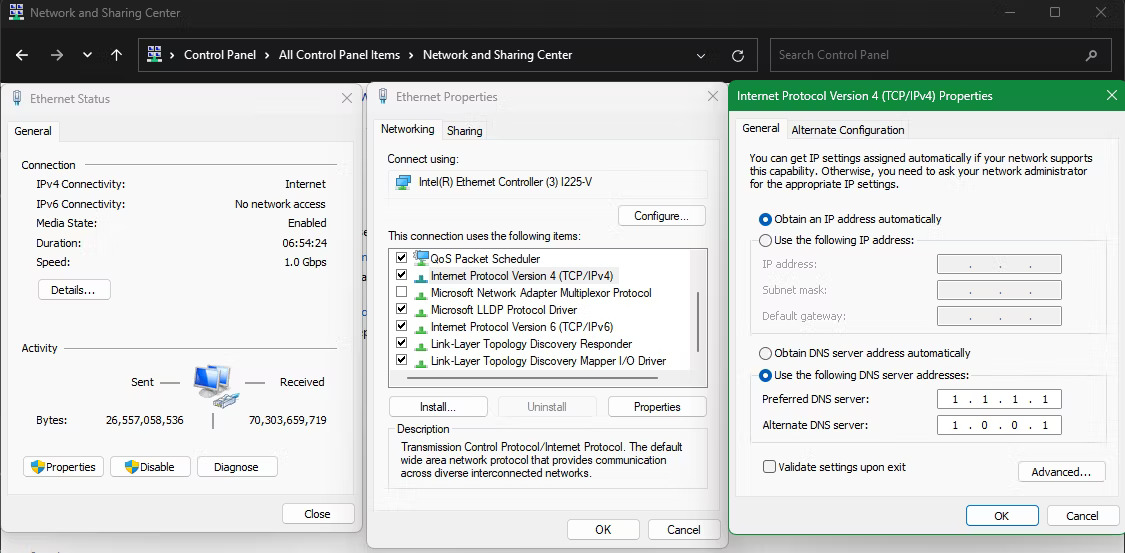
Click OK after setting both to use the automatic values, then try online again.
Check IP options on Windows 11
If you are using Windows 11, reopen Settings and go to Network & internet . Click Advanced network settings at the bottom of the list, then select the network connection you're using. In the expanded list, select View additional properties at the bottom.

On the resulting menu, make sure IP assignment and DNS server assignment are both set to Automatic (DHCP). If not, click the Edit button next to these and change both to Automatic . After confirming this, try connecting again.
7. Check ISP status
If you still can't get any devices online, you should check to see if your Internet service provider (ISP) is having problems. Although this is rare, it could explain why you cannot access the Internet on many devices.
Use your phone's data connection to see if your home's service company is reporting an outage. DownDetector is a great site for this because it includes an outage map to show where reports are happening. A quick Google or X search can also reveal whether others are having problems.
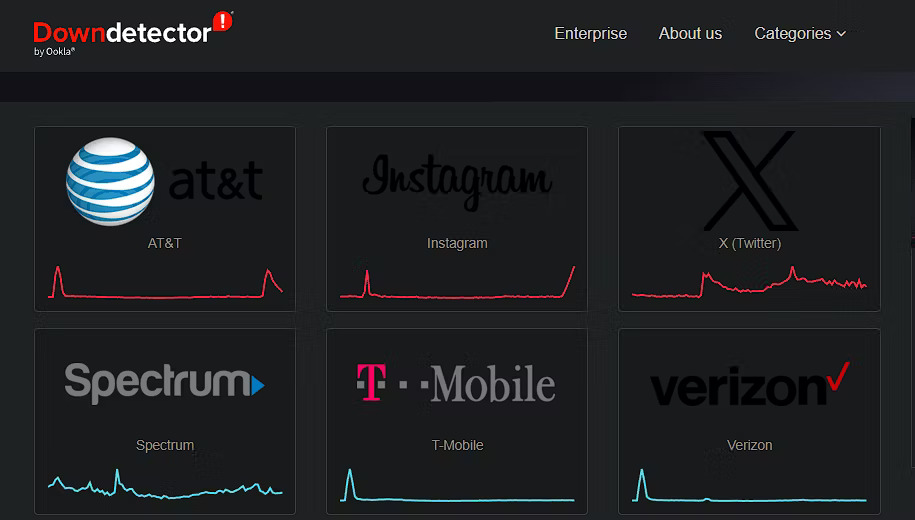
8. Try network tools in Command Prompt
This step is not necessary if the connection problem affects multiple devices.
Windows provides a number of networking commands in the Command Prompt. You should run a few of them if you still cannot access the Internet in Windows. Type cmd into the Start menu, then right-click on it and select Run as administrator to open a Command Prompt window with admin rights.
To reset some files Windows keeps for Internet access, use these two commands:
netsh winsock reset netsh int ip resetIf that doesn't work, try releasing your computer's IP address and getting a new IP address from the router with the following two commands, one at a time:
ipconfig /release ipconfig /renewFinally, refresh your computer's DNS settings with this command:
ipconfig /flushdnsThere is no harm in restarting the PC at this point. If you continue offline, you can try a few more steps.
9. Disable security software
This step is not necessary if the connection problem affects multiple devices.
Another uncommon but possible situation is that you have security software on your PC that prevents Internet access. Avast and other antivirus suites have had problems in which glitchy updates block certain websites - or even the entire Internet - for no good reason.
Disable any installed third-party antivirus applications and see if connectivity returns. If this is the case, it is necessary to change the settings in the antivirus application or consider using an alternative solution.
As for security, it's a good idea to run a malware scan using an app like Malwarebytes. Although unlikely, a malicious program could have taken down your Internet connection.
10. Update the wireless driver

This step is not necessary if the connection problem affects multiple devices.
Usually, it is not necessary to update most computer drivers because doing so can cause more problems. But if network connection problems persist, you should check for driver updates for your computer's wireless chip.
If you have a manufacturer update application (such as HP Support Assistant or Lenovo System Update) installed on your PC, open it and check for wireless driver updates. If not, follow TipsMake's instructions to update Windows drivers manually.
11. Reset the network
If you've done all the steps above and are still having trouble accessing the Internet even though you're connected to Wi-Fi, there's nothing else you can do other than reset your network settings.
If your Windows PC is the only device that cannot connect, you can reset its network configuration on Windows 10 by going to Settings > Network & Internet > Status . Click Network reset at the bottom of the screen, then select Reset now . On Windows 11, go to Settings > Network & internet , then click Advanced network settings and select Network reset .
Following the prompts in these menus will completely remove all network adapters and return all network settings to default. You'll have to reset everything, including the VPN software, but this may be the fix to go for.

When you can't get online with any device in your home, the best way is to reset the router (and modem, if necessary). Find a small pinhole on the back or bottom of the router and press on it (using a paperclip or similar object) for a few seconds to reset to factory defaults. If there is no physical reset button, you will need to log in to the router and perform a factory reset from there.
Once everything has been reset, you can go through the initial setup again and use the factory default settings to see if you can get back online. If you still have no Internet connection after that, your device may be faulty and needs to be replaced. If the device is still under warranty, contact the manufacturer.
Hopefully you don't have to factory reset anything to fix your connection issues. One of the previous steps above should solve this problem, but there is no perfect formula for network problems. Follow all the steps to confirm that your device is set up correctly and there isn't anything blocking the connection.
You can move on to more comprehensive troubleshooting if you want. However, it's a good idea to reach out to a cyber-savvy friend for more help instead.
You should read it
- How to fix the problem of not connecting to WiFi in Windows 10
- How to fix Bluetooth and Wifi connection errors on Android 8.0 Oreo
- Android error Wifi connection is flickering, this is how to fix the error
- You have problems with Wifi on iOS 11? This is how to fix it
- Fixed driver disconnection when connecting to WiFi connection
- Fixing the error 'WiFi doesn't have a Windows 10 configuration IP validation'
 6 ways to fix network not available error on Chromebook
6 ways to fix network not available error on Chromebook Why are some Internet service providers slow to adopt IPv6?
Why are some Internet service providers slow to adopt IPv6? Users can only use a maximum of about 40% of the package's network speed
Users can only use a maximum of about 40% of the package's network speed How to fix laptop error not connecting to WiFi, fix laptop error not receiving WiFi
How to fix laptop error not connecting to WiFi, fix laptop error not receiving WiFi Some ways to improve Wi-Fi connection and speed up WiFi
Some ways to improve Wi-Fi connection and speed up WiFi What is 1.1.1.1? How does it speed up the Internet and secure data when browsing?
What is 1.1.1.1? How does it speed up the Internet and secure data when browsing?